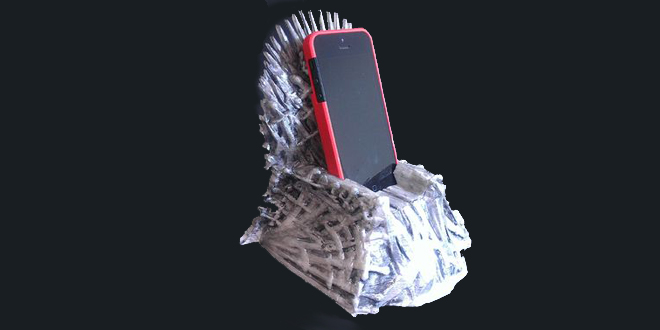
This nifty little dock was understandably hit with a cease-and-desist from HBO. Courtesy of nuPROTO.
Latest News
August 30, 2013
Modern societies increasingly associate ownership of material objects with success. It isn’t enough just to own a lot of stuff, either, you have to own the trendy or expensive items to be considered successful. That sort of lifestyle is really only obtainable by a small percentage of any population. The have-nots simply can’t afford to follow trends while working minimum wage or low-income jobs.
The programming that tells poor people they should have more and better stuff doesn’t go away just because they can’t afford the latest iPhone. Some people will overcome the materialistic culture, some will sacrifice necessities, and some will look for alternative methods of acquisition. In the digital age, one of the most common alternative methods of acquisition is internet piracy.
Said piracy used to be mainly the concern of the motion picture, video game and music industries. The dawning age of consumer driven customizable manufacturing, courtesy of 3D printing, has resulted in other industries beginning to feel some of the same pressure to defend copyright and intellectual property (IP). HBO recently sent a cease-and-desist letter to man who designed an printable iPod dock based on the throne from the Game of Thrones television series.
In order to avoid a massive overreaction to the potential threats to IP posed by additive manufacturing (AM), some sort of digital rights management (DRM) must emerge to at least make the wholesale digital piracy of objects less appealing. The US government is already somewhat spooked by the idea of people building guns using AM, adding wholesale commercial piracy to the equation doesn’t make the technology seem less threatening to national interests.
Not just any DRM technology will do for AM, either. Unscrupulous sorts already have patents of dubious legality regarding certain types of DRM aimed at 3D printing, but that kind of draconic protection has proven unpopular with consumers as well as being rather pointless. Hard encoded DRM is just as likely to interfere with legitimate users as it is to deter piracy.
A company named Authentise has a different idea about how DRM should work for AM. The company’s SendShapes management system takes a page from streaming services. SendShapes allows users to purchase the 3D design for an object, then sends the design in bits and pieces to an AM system, generating just enough data to complete a print, but not enough (in theory) for pirates to capture the entire design. Once a print is finished, all data about the object that was built is erased.
The idea is, of course, not perfect. What happens if your printer malfunctions halfway through a print? How will partial transactions of that nature be legitimately tracked? How will the company deal with problems like identity theft?
No system of protection is 100% reliable, either. People with the will to steal something will always figure out a new ways to steal. History (and iTunes) has shown, however, that given a reasonably priced, easy-to-use option, most people will choose to buy products rather than steal. SendShapes seems like a fairly non-intrusive type of DRM that shouldn’t cause more problems than it solves.
In addition to pure, digital DRM, Authentise is working on a way to insert forensic markers into 3D printed objects. The basic idea is that a design would have a “fingerprint” unique to that design that could be identified. Any object with the fingerprint that hasn’t been legally purchased would be easy to identify.
Hopefully something like Authentise’s ideas eventually pans out. AM is too useful a technology to be locked away from the average consumer simply because big business fears for its bottom line. Below you’ll find a short video about SendShapes.
Source: MIT Technology Review, Authentise
Subscribe to our FREE magazine, FREE email newsletters or both!
Latest News
About the Author
John NewmanJohn Newman is a Digital Engineering contributor who focuses on 3D printing. Contact him via [email protected] and read his posts on Rapid Ready Technology.
Follow DERelated Topics







